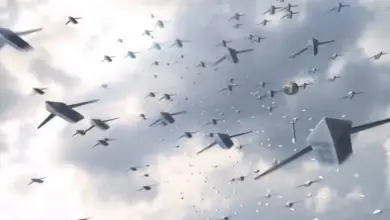It is not a secret that for Moscow, Syria has become the “ultimate testing ground” for its weapons. Russian forces have been particularly successful at using electronic warfare (E.W.) technology to interfere with operations of the United States and its allies on the territory of the Arab republic.
In a speech last month at the U.S. Geospatial Intelligence Foundation’s 2018 GEOINT Symposium, General Raymond Thomas, commander of U.S. Special Operations Command, said Syria has become “the most aggressive E.W. environment on the planet.”
“They are testing us every day, knocking our communications down, disabling our EC-130s, etcetera,” he said. Even though the general did not directly say Moscow was behind the operations, according to experts, it is only Russia that has advanced capabilities to successfully carry out such interference in Syria.
Thomas’ comments came soon after reports that Russia has been blocking small U.S. surveillance drones from receiving GPS satellite signals.

One Russian system capable of such interference is the Krasukha-4. It is designed primarily to counter the radars of attack, reconnaissance and unmanned aircraft, and has reportedly been deployed to Syria. The truck-mounted radio emitter is capable of jamming not only radar signals, but also control channels for drones, making planes “blind and deaf.” It has a range of up to 300 km (185 miles).
Other systems reportedly used by the Russian military in Syrian territory include the Richag-AV radar and sonar jamming system and the Moscow-1, designed to scan the airspace and transfer the obtained data to E.W. systems to neutralize targets.

Conor McKenna, Doctoral Researcher in Cyberwarfare at the University of Birmingham, told The Defense Post that the intended consequence of jamming are to deter information gathering, and other military operations, by the U.S. and its allies.
“By doing this, Russia is hoping to preserve their interests in the region through limiting future incursions,” he said. “Intelligence, logistics and other support depend heavily on these technologies and by undermining the ability to trust these technologies, Russia might expect the result to be fewer operations against its allies in Syria.”
According to U.S. officials, jamming has seriously affected the campaign against Islamic State.
McKenna said this form of electronic warfare has the ability to cause damage and undermine the capacity of forces operating in the region.
“There are dangers when relied-upon equipment fails in these situations. Jamming of this nature can cause significant damage; removing GPS from a drone has the potential to cause crashes or other failures, while radar and communications issues remain big concerns,” he said.
The U.S. Department of Defense declined to comment on the frequency of these incidents or clarify whether any additional protection measures are being taken.
“For operational security reasons, we don’t discuss E.W., to include our detection or protection from these kinds of operations,” Pentagon spokesperson Adrian Rankine-Galloway told The Defense Post.
Eric Pahon, another Pentagon spokesperson, has previously noted, however, that the “U.S. military maintains sufficient countermeasures and protections to ensure the safety of our manned and unmanned aircraft, our forces and the missions they support.”

“The U.S. is not the only player”
According to Brandon Valeriano, Donald Bren Chair of Armed Politics at the Marine Corps University, Russia’s attempts to interfere with U.S. operations pose no significant threat.
“I don’t think they are really using this as a testing ground, more so they are using this as a signal to other opposition powers about their capabilities. And they are trying to signal to the West that they have capable cyber, or electronic warfare capabilities,” he said.
The U.S. is not getting the message, however, because no one in the U.S. military believes Russia is actually capable of jamming advanced drones and missiles, according to Valeriano.
“Jamming communications is a bit easier, but jamming GPS and other sorts of systems is bit more complicated,” he said. “I don’t think any major military power is caught off guard by any of this or dramatically threatened.”
“In many ways I think what Russia is doing is just basically crying out at the night to try and be heard by someone, but I really don’t think anyone is listening because their capabilities are vastly inferior to the West on most occasions,” he added.

E.W. operations in Syria may also be a way for Russia to compete and demonstrate to the region that the U.S. is not the only player, according to Oliver Fitton, a PhD candidate in International Relations at the Department of Politics, Philosophy and Religion at the University of Lancaster.
“They force the U.S. to take note that they are being challenged (resulting in a change of tactic and maybe even an overreaction that sees the U.S. shelve certain types of operations for fear that Russia will win operations fight),” he told The Defense Post.
Russia and the U.S. have very different attitudes towards risk in the “less than war” environment, Fitton noted.
“Russia can’t compete with the U.S. on the grand strategic stage in the same way it once could, so Russia seeks new ‘less than war’ ways of competing for power (influence, territory etc). One of the key problems for the U.S. today is that it’s really good at the grand strategic deterrence stuff but it’s really inflexible when it comes to be being challenged by an actor that isn’t using big guns,” he said.
“Russia may have an advantage”
In 2016, Lieutenant General Ben Hodges, who was then the commanding general for U.S. Army Europe, said that the U.S. was able to learn about Russia’s E.W. capabilities based on Russian operations in Ukraine.
“We’re learning an awful lot from the environment in Ukraine, both the capabilities we’ve seen the Russians display in Crimea — electronic warfare capability at a tactical level that we absolutely don’t have,” he stated.
Nazli Choucri, a professor of political science at the Massachusetts Institute of Technology, told The Defense Post that Russia may have an advantage over the U.S. because of the speed with which tech and cyber tools can be harnessed and mobilized.
“Where is the edge or the constraints? I think they are at home,” she said. “I suspect Russia may have an advantage – less process barriers for weapon related acquisitions.”

Electronic warfare is a relatively inexpensive way to curb an opponent’s ability to communicate and exercise control within a battlespace. For example, during an interview in 2015, Hodges said Russia demonstrated the ability to completely shut down “everything” used by the Ukrainians for communications.
“OSCE [Organization for Security and Co-operation in Europe] has reported that the drones they use for monitoring are being interfered with,” he said. “There is imagery, public pictures of Russian systems in Crimea that are absolute state of the art.”
Hodges underscored at the time that multinational interoperability and secure FM channels were important for future operations.
“We need to have secure FM communications. Without that, soldiers will do what they have to do. They will go unsecure, which then means the Russian E.W. capability jams it or finds it, intercepts it, targets it. That’s why this is a big deal,” he has said. “We have to improve that interoperability that I described, but also we have got to start practicing that we are not going to have uncontested cyber domain like we did in Afghanistan or Iraq.”

“The superiority of Russian systems is not overwhelming”
Vladimir Neelov, a military expert at the Russian Center for Strategic Perspectives Research, told The Defense Post that over the past several decades, U.S. military strategy has been based on the conviction that U.S. troops would face much weaker opponents, such as insurgents, terrorists and pirates. That’s why stress has been placed on the strategy and tactics related to irregular warfare and counterinsurgency.
“In other words, after the 1991 Gulf war, the U.S. military has had no experience in confronting an opponent equal in strength. Accordingly, its combat training programs and priorities in the procurement of weapons have changed,” he explained.
However, since U.S.-Russia relations soured in 2014, the U.S. military and experts have started to pay more attention to Russian E.W. capabilities.
“Russian electronic warfare weapons are superior to American systems by a number of parameters, especially when it comes to range,” Neelov said. “In particular, they are effective against unmanned aerial vehicles, as the Syria experience has shown. However, this does not mean that the Americans have nothing to counter the Russian side with; it’s just the environment in which they have to operate is more complex, which leaves its imprint on the planning of current and future operations.”
Many of the problems inherent in the U.S. armed forces are also characteristic of the Russian army, in particular a tilt toward counterinsurgency operations stemming from the experience of fighting in the Caucasus, Neelov noted.
“At the same time, the requirement to be ready to conduct combined arms operations during a war with an equal or even more technologically advanced enemy on land and in the air is still the key. Hence, the bet [was placed] on the development and accelerated supply of electronic warfare complexes to the troops, in particular ‘Krasukha-4,’ ‘Moscow,’ ‘Vitebsk’ and many others,” he said.
The Russian army’s dependence on technology is not as strong and mission critical compared to that of the U.S. for one obvious reason: they have less-sophisticated equipment, Neelov explained.
“The superiority of Russian systems is not overwhelming, it is not able to reduce to zero the capabilities of U.S. forces in Syria … For example, the story so beloved by Russian journalists about the alleged ability of Russian aviation to disable USS Donald Cook, is nothing more than propaganda,” he noted. “As for the statement of General Thomas, it is worth noting that he did not say anything new, having voiced previously known facts. Why did he make such a statement now and what was his goal? One can only guess.”
Red Army in the grey zone: Russia’s greatest threat to the US is ‘less-than-war’













